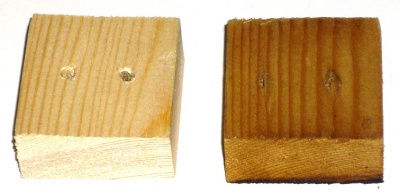Difference between revisions of "Tea wood stain"
Jump to navigation
Jump to search
(pic) |
(a bit) |
||
| Line 1: | Line 1: | ||
| − | |||
| − | |||
[[image:Spruce after 2 weeks in tea 0395-9.jpg|400px]] | [[image:Spruce after 2 weeks in tea 0395-9.jpg|400px]] | ||
Spruce blocks before and after a 2 week soak in strong tea. | Spruce blocks before and after a 2 week soak in strong tea. | ||
| + | |||
| + | '''Tea''' is a very economical wood stain, but slow. | ||
==Stain recipe== | ==Stain recipe== | ||
| Line 11: | Line 11: | ||
==Issues== | ==Issues== | ||
| − | The wood is saturated and must dry out afterwards. This | + | The [[wood]] surface is saturated and must dry out afterwards. This creates some risk of warping, perhaps even splitting. |
| − | Time.... its a | + | Time.... its a slow process! Shorter immersion gives lighter shades, and stain can just be wiped on for light results. A stronger brew is quicker. |
Black slime formed on the top of the tea and caused patchy black marks on the top of the wood (the side not shown in the photo) This can be avoided by keeping the wood under the [[water]] surface. | Black slime formed on the top of the tea and caused patchy black marks on the top of the wood (the side not shown in the photo) This can be avoided by keeping the wood under the [[water]] surface. | ||
| + | |||
| + | ==Other stains== | ||
| + | Coffee has also been used. | ||
| + | |||
| + | There are various other freeish materials that can stain wood, but almost all of them fade after not long, including beetroot. | ||
Revision as of 14:48, 12 April 2013
 Spruce blocks before and after a 2 week soak in strong tea.
Spruce blocks before and after a 2 week soak in strong tea.
Tea is a very economical wood stain, but slow.
Stain recipe
- One teabag (standard black tea) in a mug
- Add boiling water
- Leave till next day and remove teabag
- Soak wood for 2 weeks, keeping it under the water's surface
Issues
The wood surface is saturated and must dry out afterwards. This creates some risk of warping, perhaps even splitting.
Time.... its a slow process! Shorter immersion gives lighter shades, and stain can just be wiped on for light results. A stronger brew is quicker.
Black slime formed on the top of the tea and caused patchy black marks on the top of the wood (the side not shown in the photo) This can be avoided by keeping the wood under the water surface.
Other stains
Coffee has also been used.
There are various other freeish materials that can stain wood, but almost all of them fade after not long, including beetroot.